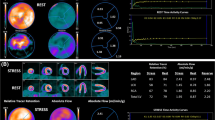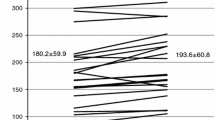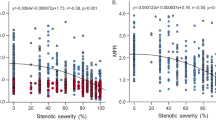Abstract
Objective
Myocardial blood flow (MBF) is measured with 82Rb using non-linear, least-squares computerised modelling. The study aim was to explore the feasibility of Gjedde–Patlak–Rutland (GPR) graphical analysis as a simpler method for measuring MBF.
Methods
Patients had myocardial perfusion imaging using adenosine (n = 45) or regadenoson (n = 33) for stressing. Blood 82Rb clearance into myocytes (K1) was measured from Cedar-Sinai QPET software using the modified Crone–Renkin equation of Lortie et al. (K1 = [1–0.77 × e−B/MBF] × MBF) to convert K1 to MBF (ml/min/100 ml), where B (63 ml/min/100 ml) is myocardial permeability-surface area product. Using aorta or left ventricular cavity (LV) to measure arterial blood 82Rb concentration, blood 82Rb clearance into myocardium (Z) was measured from GPR analysis based on data acquired between 1 and 3 min post-injection. As units of K1 and Z are, respectively, ml/min/ml intracellular space and ml/min/ml total tissue including extracellular space, myocardial extracellular fluid volume (ECV) is 1 − [Z/K1]. Using Z/K1 (see Results) to modify its index, the Lortie equation was changed to Z = (1–0.77 × \(e^{-B_Z/\text{MBF}_Z}\)e−BZ/MBFZ)*MBFZ, following which MBFZ was calculated from Z. In GPR analysis, spillover of activity from LV to myocardium conveniently ‘drops out’ in the intercept of the plot.
Results
Both agents increased myocardial blood flow almost equally. ECV was ~ 35 ml/100 ml at rest, increasing to ~ 40 ml/100 ml after stress. Z/K1, averaged between stress, rest, stressing agents and arterial ROI, was 0.62, so BZ was taken as 39 (i.e. 0.62 × 63) ml/min/100 ml. Based on LV, MBFZ (y) correlated with MBF (x): y = 0.43x + 22 ml/min/100 ml; r = 0.84; n = 156). Their respective stress/rest ratios showed a moderate correlation (r = 0.64; n = 78).
Conclusions
GPR analysis offers promise as a valid and analytically simpler technique for measuring myocardial blood flow, which, as with any clearance measured from GPR analysis, has units of ml/min/ml total tissue volume, and merits development as a polar map display.



Similar content being viewed by others
References
Sapirstein LA. Fractionation of the cardiac output of rats with isotopic potassium. Circ Res. 1956;4:689–92.
Choi Y, Huang S-C, Hawkins RA, Kuhle WG, Dahlbom M, Hoh CK, et al. A simplified method for quantification of myocardial blood flow using nitrogen-13-ammonia and dynamic PET. J Nucl Med. 1993;34:488–97.
Kitsukawa S, Yoshida K, Mullani N, Nakagawa K, Shimada K, Takami A, et al. Simple and Patlak models for myocardial blood flow measurements with nitrogen-13-ammonia and PET in humans. J Nucl Med. 1998;39:1123–8.
Yoshida K, Mullani N, Gould KL. Coronary flow and flow reserve by PET simplified for clinical applications using rubidium-82 or nitrogen-13-ammonia. J Nucl Med. 1996;37:1701–12.
Lortie M, Beanlands RSB, Yoshinaga K, Klein R, Dasilva JN, DeKemp RA, et al. Quantification of myocardial blood flow with 82Rb. Dynamic PET imaging. Eur J Nucl Med Mol Imaging. 2007;34:1765–74.
Lautamäki R, George RT, Kitagawa K, Higuchi T, Merrill J, Voicu C, et al. Rubidium-82 PET-CT for quantitative assessment of myocardial blood flow: validation in a canine model of coronary artery stenosis. Eur J Nucl Med Mol Imaging. 2009;36:576–86.
deKemp RA, Declerck J, Klein R, Pan XB, Nakazato R, Tonge C, et al. Multisoftware reproducibility study of stress and rest myocardial blood flow assessed with 3D dynamic PET/CT and a 1-tissue-compartment model of 82Rb kinetics. J Nucl Med. 2013;54:571–7.
Renkin EM. Transport of potassium-42 from blood to tissue in isolated mammalian skeletal muscles. Am J Physiol. 1959;197:1205–10.
Crone C. The permeability of capillaries in various organs as determined by use of the ‘indicator diffusion’ method. Acta Physiol Scand. 1963;58:292–305.
Keramida G, Gregg S, Peters AM. Stimulation of the hepatic arterial buffer response using exogenous adenosine: hepatic rest/stress perfusion imaging. Eur Radiol. 2020;15:14. https://doi.org/10.1007/s00330-020-06984-6 (Online ahead of print.PMID: 32594209).
Peters AM. The precise physiological definition of tissue perfusion and clearance measured from imaging. Eur J Nucl Med Mol Imaging. 2018;45:1139–41.
Keramida G, Gregg S, Peters AM. Intrahepatic fluorine-18-fluorodeoxyglucose kinetics measured by least square nonlinear computer modelling and Gjedde-Patlak-Rutland graphical analysis. Nucl Med Commun. 2019;40:675–83.
Coxson PG, Brennan KM, Huesman RH, Lim S, Budinger TF. Variability and reproducibility of rubidium-82 kinetic parameters in the myocardium of the anesthetized canine. J Nucl Med. 1995;36:287–96.
Herrero P, Markham J, Shelton ME, Bergmann SR. Implementation and evaluation of a two-compartment model for quantification of myocardial perfusion with rubidium-82 and positron emission tomography. Circ Res. 1992;70:496–507.
Sado DM, Flett AS, Banypersad SM, White SK, Maestrini V, Quarta G, et al. Cardiovascular magnetic resonance measurement of myocardial extracellular volume in health and disease. Heart. 2012;98:1436–41.
Gould KL, Yoshida K, Hess M-J, Haynie M, Mullani N, Smalling RW. Myocardial metabolism of fluorodeoxyglucose compared to cell membrane integrity for the potassium analogue rubidium-82 for assessing infarct size in man by PET. J Nucl Med. 1991;32:1–9.
Dahl J, Muzik O, Wolfe ER, Allman C, Hutchins G, Schwaiger M. Myocardial rubidium-82 tissue kinetics assessed by dynamic positron emission tomography as a marker of myocardial cell membrane integrity and viability. Circulation. 1996;93:238–45.
Ziegler WH, Goresky CA. Kinetics of rubidium uptake in the working dog heart. Circ Res. 1971;29:208–20.
Munk OL, Bass L, Roelsgaard K, Bender D, Hansen SB, Keiding S. Liver kinetics of glucose analogs measured in pigs by PET: importance of dual-input blood sampling. J Nucl Med. 2001;42:795–801.
Funding
This study was not funded.
Author information
Authors and Affiliations
Corresponding author
Ethics declarations
Conflict of interest
Sima Gregg declares she has no conflicts of interest. Georgia Keramida declares she has no conflicts of interest. A Michael Peters declares he has no conflicts of interest.
Ethical approval
All procedures performed in studies involving human participants were in accordance with the ethical standards of the institutional and/or national research committee and with the 1964 Helsinki declaration and its later amendments or comparable ethical standards. This article does not contain any studies with animals performed by any of the authors.
Informed consent
Informed consent was obtained from all individual participants included in the study.
Additional information
Publisher's Note
Springer Nature remains neutral with regard to jurisdictional claims in published maps and institutional affiliations.
Rights and permissions
About this article
Cite this article
Gregg, S., Keramida, G. & Peters, A.M. Measuring myocardial blood flow with 82rubidium using Gjedde–Patlak–Rutland graphical analysis. Ann Nucl Med 35, 777–784 (2021). https://doi.org/10.1007/s12149-021-01591-x
Received:
Accepted:
Published:
Issue Date:
DOI: https://doi.org/10.1007/s12149-021-01591-x




